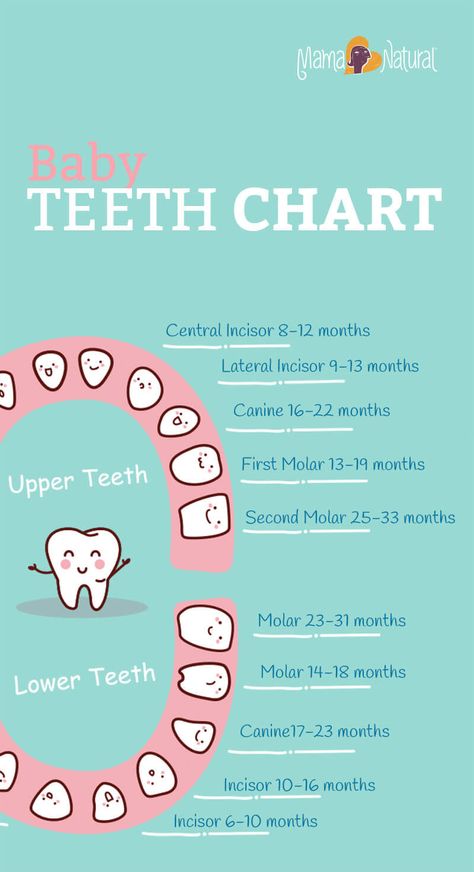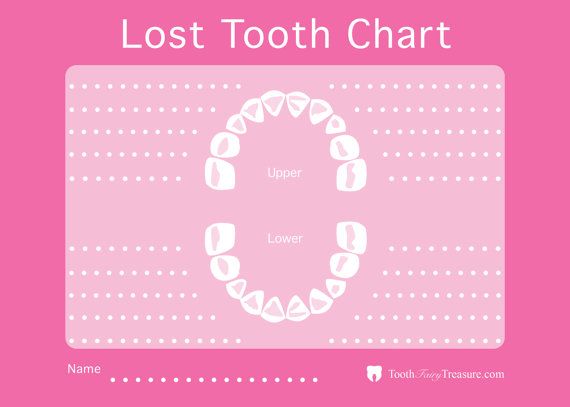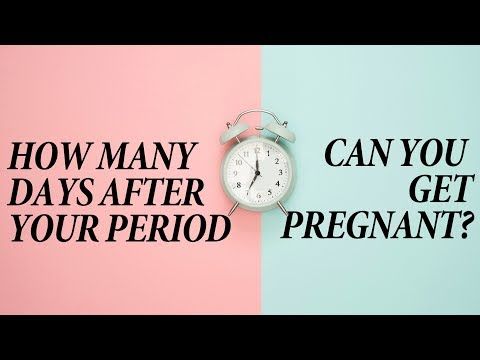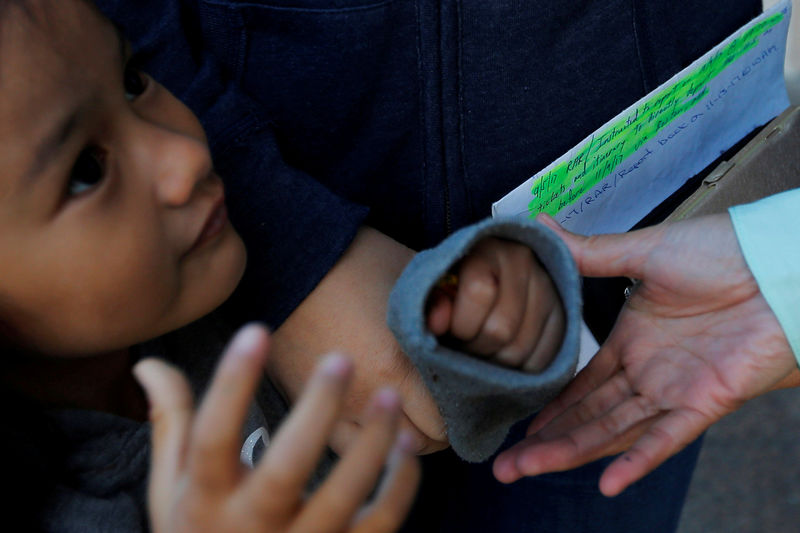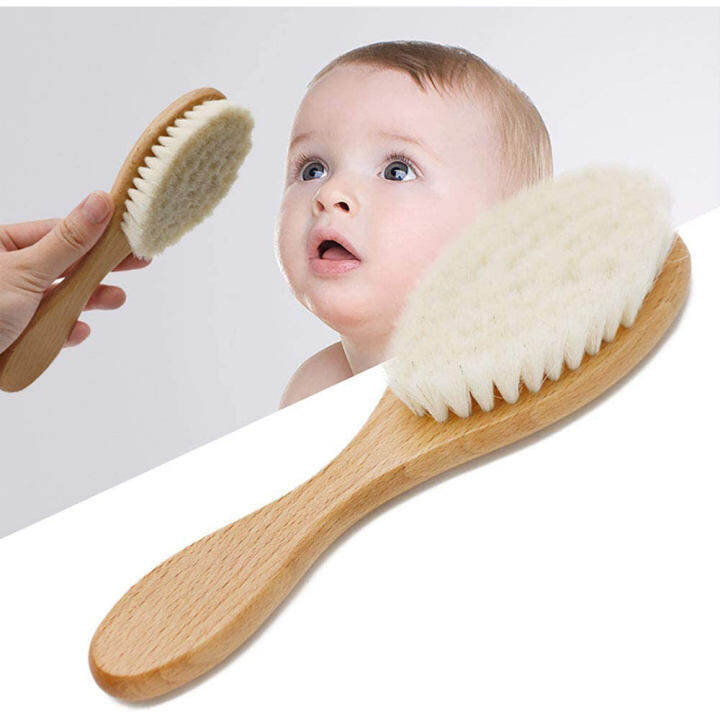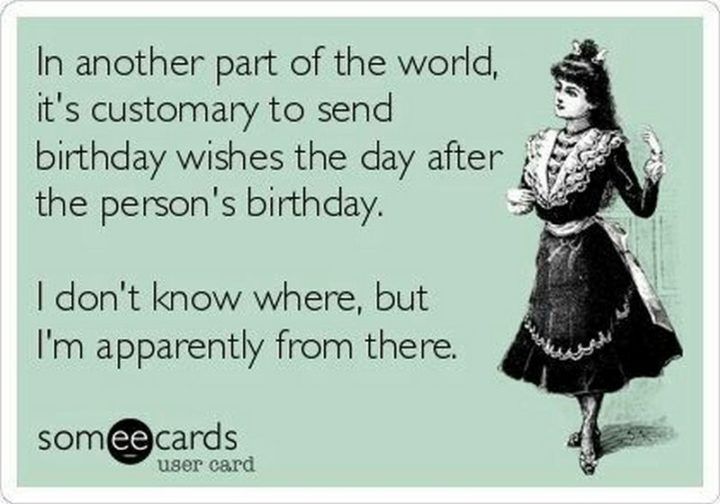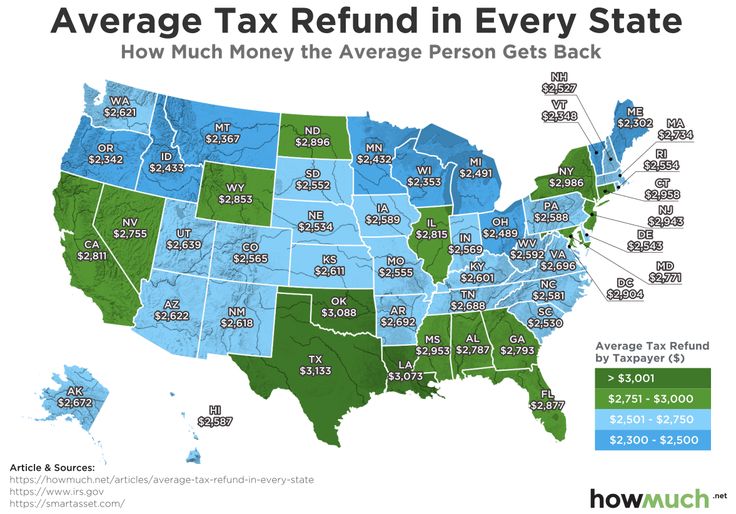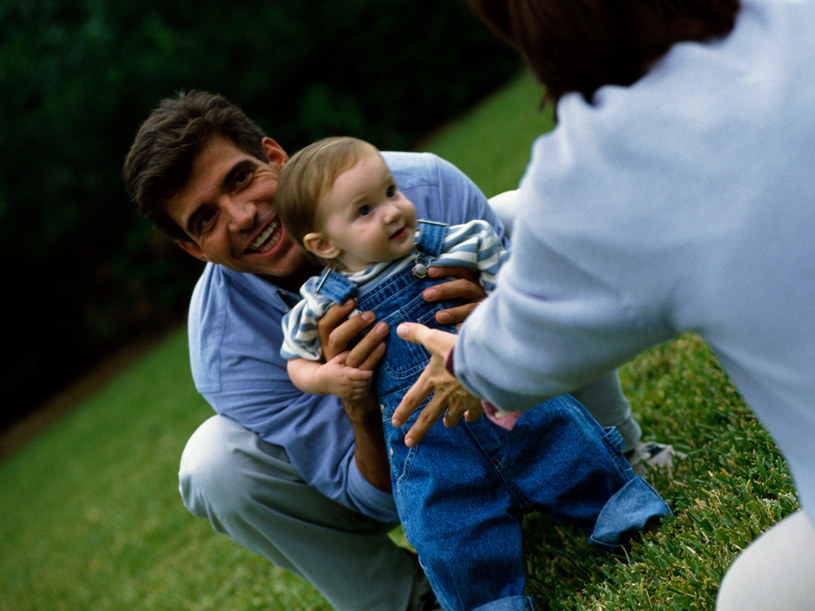How to give baby massage
Baby Massage: How and Why You Need to Do It
From improved sleep to a better bond, baby massage has so much to offer baby and caregiver. Find out more, plus learn the best techniques.
What’s not to love about a massage? No matter what kind of massage you get—from a deep tissue massage to a prenatal massage and even a perineal massage (OK, that’s a bit of a stretch)—you receive physical and mental benefits. So why not try baby massage for your littlest one. There are some significant benefits to infant massage that we’ll explore in this post.
With that in mind, in this post we’ll explain:
How to Do a Baby Massage
You’re ready to massage baby, but what exactly are you supposed to do? Just follow a few simple steps:
1. Set the mood
Dim the lights, shut off your phone, turn on some soft music if you’d like, and make sure the room is warm. What’s considered warm? About 75 degrees F.
2. Place baby on a safe surface
Choose a comfortable, but flat surface. This may be a floor, your bed (don’t leave baby unattended!), or baby’s changing table.
3. Undress baby
You can ditch the diaper if you want. A little air time will even be beneficial for baby’s bum if she has a diaper rash or heat rash. Just be sure to slide a towel or two under baby if they are diaper-free. The prefold inserts for cloth diapers work well in this situation.
4. Gentle touch
Now is not the time for tickling. You want a calm, peaceful mood. For small infants, use soft, gentle strokes. For toddlers, you can use more firm “massage” strokes. Think of a massage stroke as smoothing your baby’s skin, rather than rubbing it.
5. Target the right body parts
Benefits of Baby Massage – Mother Massaging Baby’s Foot
Massage baby’s feet using soft, gentle strokes.
Benefits of Baby Massage – Mother Massaging Baby’s Legs
Massage baby’s legs, working the shins and the thighs.
Benefits of Baby Massage – Mother Massage Baby’s Arms
Move to the arms, making sure to massage baby’s hands, too.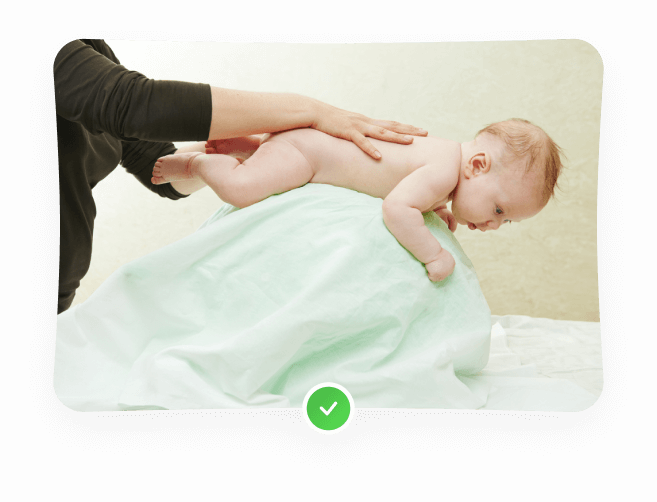
Benefits of Baby Massage – Mother Massage Baby’s Stomach
For baby’s stomach, massage in a clockwise direction (the same way as baby’s digestive system moves).
Benefits of Baby Massage – Mother Massage Baby’s Chest
Massage baby’s chest, but avoid the delicate head and neck area.
Benefits of Baby Massage – Mother Massage Baby’s Back
Flip baby over and massage his/her back.
*Avoid massaging the head since your baby still has soft spots
6. Bond with your baby
Talk softy, sing a lullaby, or gently shhhhh your baby. Look baby in the eyes to enhance the connection between the two of you.
7. Know when to stop
If baby starts to fuss, stop the massage and resume at a later time. Common reasons why babies start to fuss during a massage is that they are hungry, too cold, or even bored. Hey, babies are human too! ?
Feeling motivated? Here’s a good example of infant massage:
Do I Need Baby Massage Oil?
While you don’t need baby massage oil, using massage oil can make the experience more comfortable and enjoyable, because it lessens the friction between skin.
According to a study published in the journal Indian Pediatrics, the type of massage oil you use can affect the health and growth of your baby. Researchers found that when coconut oil (as opposed to mineral oil) was used, the babies (both preterm and full-time) gained more weight.
Recent research from the University of Manchester also studied the role of oil used in baby massages, and found that olive oil and sunflower oil seemed to break down baby’s skin barrier function. Babies massaged with these oils were more at risk for developing skin conditions like baby eczema.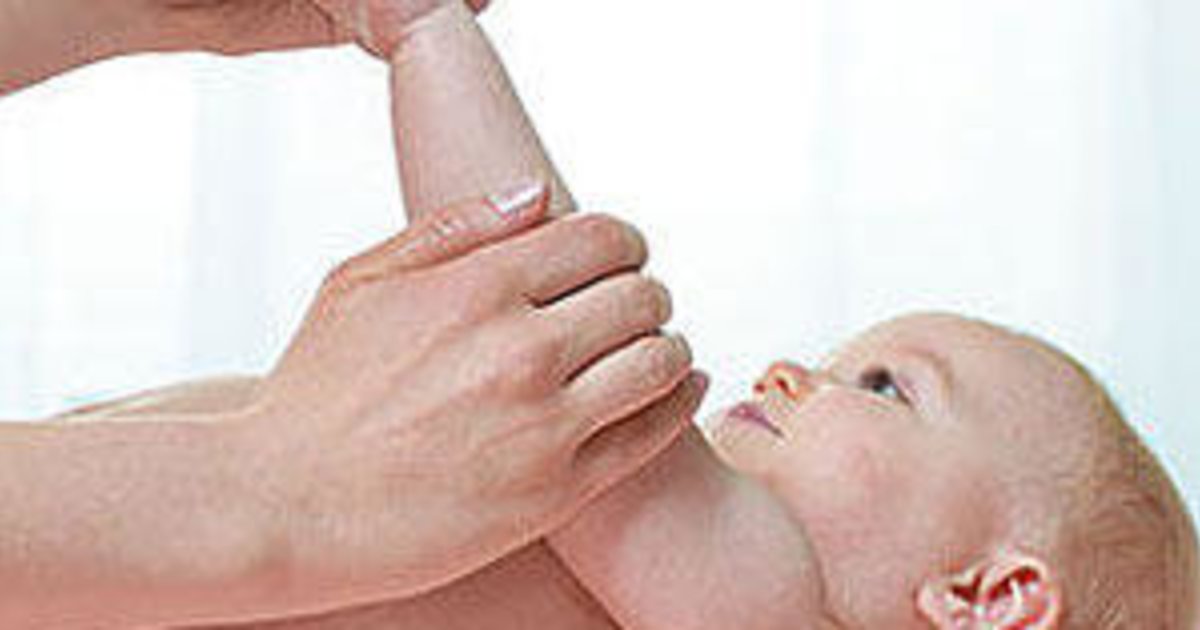
Get free updates on baby’s first year! – Free Updates on First Year [In-article]
Sign me up!
Best baby massage oil
- Coconut oil: Yes, just use a small dap of coconut oil for your massage oil. Babies don’t need fancy! Coconut oil is antimicrobial, anti-bacterial, anti-fungal, and antiviral. I kept a small jar in my baby’s drawer, as I used coconut oil for diaper cream as well. (This is my favorite brand.)
- Whipped Shea Butter with Coconut oil: If your baby has drier skin, shea butter helps to hydrate and seal in moisture. This whipped cream is mixed with coconut oil for added benefit. No other ingredients. (You can purchase here.)
- YL Seedlings: If you want something to add in the therapeutic value of essential oils, try this gentle and nourishing baby massage oil. (Get more info on ordering YL here.)
Using essential oils
Never apply undiluted essential oils to a baby’s skin—they are too concentrated and can cause allergic reactions, skin irritations, or a detox response. Always ensure proper dilution ratios when using essential oils near or for children. Best to use occasionally versus daily.
Always ensure proper dilution ratios when using essential oils near or for children. Best to use occasionally versus daily.
When to Massage Baby
For most parents, only five minutes per diaper change is enough to encourage a healthy digestive system, ease symptoms of colic, and promote a quiet and restful evening. (source)
Age
It’s never too early to start massaging your baby. Your baby’s first massage might even be on his birth day when you rub in the vernix. However, if you massage a newborn, you’ll want to be extra careful when using any oils on his sensitive newborn skin.
Time of day
The time of day you choose to massage your baby could make a difference in how well baby responds to the massage. Avoid massaging baby too soon after a feeding, since it may cause baby to spit up.
Some of the best times to massage baby are:
- About 45 minutes after eating
- When baby is calm, alert, and awake
- Right before bed
- After a diaper change
Benefits of Baby Massage
Infant massages are not new.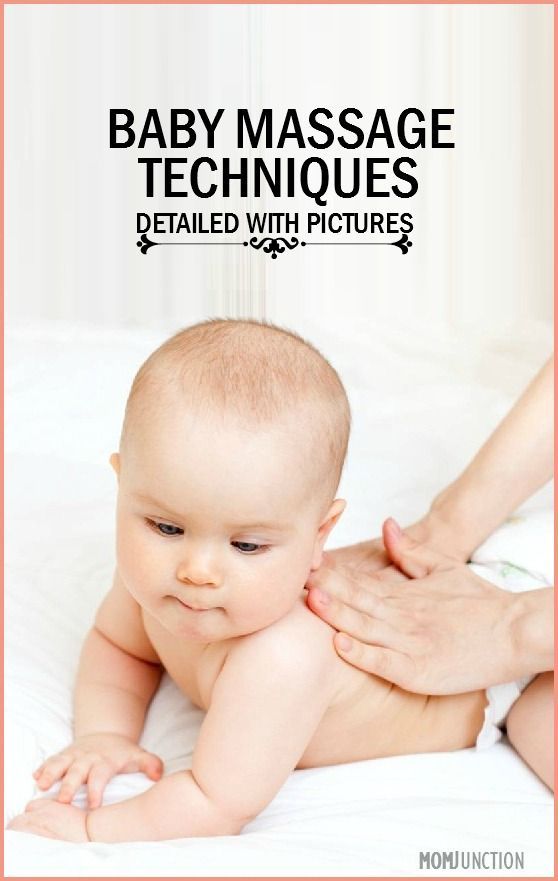 In fact, baby massages have quite the history. Evidence of the earliest infant massage dates back to ancient India. Even then, massages were more than just a form of relaxation—they were incorporated into Ayurvedic medicine as a way to enhance circulation, get rid of toxins, improve digestive function, and boost overall well-being. (source)
In fact, baby massages have quite the history. Evidence of the earliest infant massage dates back to ancient India. Even then, massages were more than just a form of relaxation—they were incorporated into Ayurvedic medicine as a way to enhance circulation, get rid of toxins, improve digestive function, and boost overall well-being. (source)
Today we know just how much a newborn benefits from massage and that all babies, particularly low birthweight babies, often thrive when exposed to human touch. Over 100 studies confirm the wide range of massage benefits for common maladies from gas to colic to sleeping problems. Let’s unpack some of the biggest benefits of baby massage:
1. Baby massage facilitates weight gain
When Stephanie Agakian gave her birth to her baby girl at 25 weeks gestation, she was a mere 1 lb 5 ounces. Agakian was told to massage her baby at home to promote growth and overall health. That’s because, many studies link massage with healthy weight gain.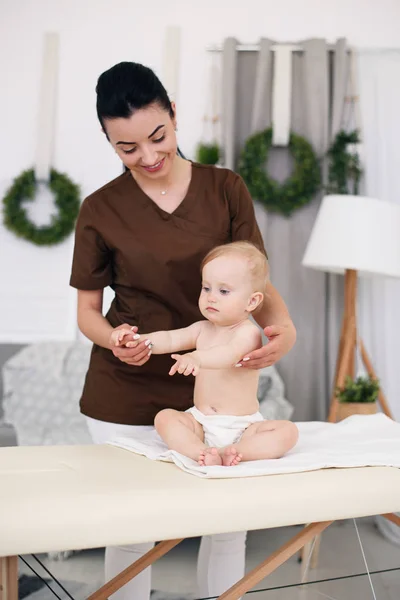
According to this study, premature babies who received “touch therapy” (a massage), gained 47 percent more weight than premature babies who did not receive any massages. (WOW!)
In another study, newborns who received massage gained more weight per day, appeared more aware, and had increased motor skills. A more recent study supports these findings, adding that baby massage increases bone density, too.
2. Baby massage lowers chance of jaundice
Recent studies suggest infant massage can also reduce bilirubin levels—the compound in blood that causes jaundice—and increase the frequency of bowl movement, which helps expel excess bilirubin from the body, not to mention constipation.
Benefits of Baby Massage – Mother Massaging Baby’s Foot
3. Baby massage reduces stress
There are many studies that show human touch reduces stress and lowers blood pressure in adults, and babies are no different.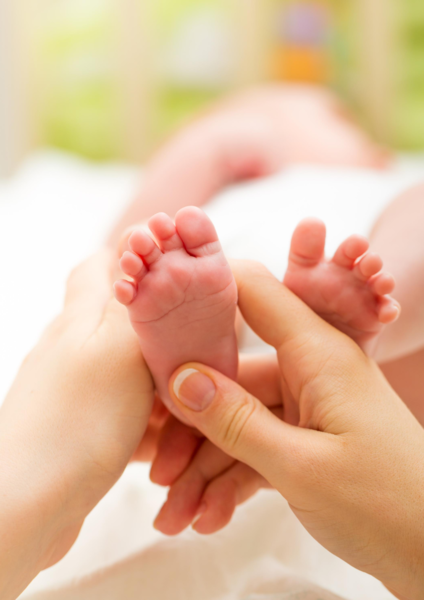 This study found evidence that massage therapy can be life-saving for premature babies.
This study found evidence that massage therapy can be life-saving for premature babies.
In one study, massaged babies showed improved heart rate variability (HRV)—a measure of nervous system function—every week. The researchers concluded baby massage markedly reduces stress and, therefore, promotes the maturation of preemies’ immature nervous systems.
So how do massages lower stress hormones? Touch causes endorphins to be released, which then causes cortisol to drop. As a result, babies’ “senses of safety and security are increased, and all of this brings the individual into a more balanced state of well-being overall,” says Ronda Cheatham, owner of A Touch of Grace Massage Therapy in Remington, Virginia.
4. Baby massage reduces colic
Have you ever wondered why so many infant seats, rockers, and swings have a vibrating feature? It’s because the vibration can actually help relieve colic. But research shows prolonged time in chairs or other baby containers are not good for baby’s development.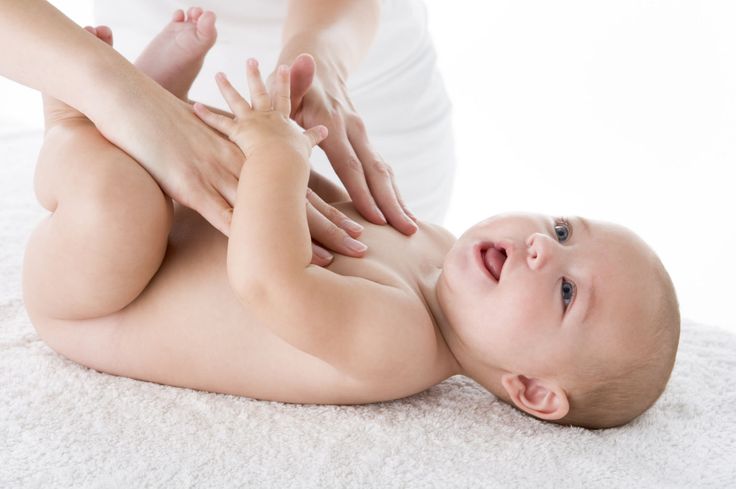 This study found that infant massage is comparable to vibrating chairs in terms of successfully calming a colicky baby.
This study found that infant massage is comparable to vibrating chairs in terms of successfully calming a colicky baby.
5. Baby massage promotes sleep
Research from the University of Warwick found that baby massage lowers levels of cortisol, the stress hormone, and stimulates melatonin production. Because melatonin’s main job is to regulate sleep cycles, baby massage helps babies fall asleep faster and stay asleep longer. (Yippee!)
“Given the apparent effect of infant massage on stress hormones, it is not surprising to find some evidence of an effect on sleep and crying,” — Angela Underdown, University of Warwick
6. Baby massage strengthens bonds between mama (or papa) and baby
Studies show that the bond between baby and mama is reinforced through eye contact as well as skin-to-skin contact. Further research suggests infant massage is especially helpful for mothers with postpartum depression who have trouble bonding with their babies.
“When parents massage their baby, hormones are released to help [the parents] relax. Through massage, they learn to understand their baby, building their confidence…” — Linda Storm, founding executive director of Infant Massage USA
But the benefits don’t just apply to mama. A study published in the Journal of Perinatal Education found that baby massage significantly reduced paternal stress and improved the bond between dad and baby.
Studies also show that parents who practice infant massage are better able to communicate with their children. And parents of chronically ill children report lower levels of anxiety as a result of practicing baby massage.
7. Baby massage relieves gas or constipation
Because babies have an underdeveloped sphincter in their esophagus, they aren’t able to burp on their own. This causes gas to build up in their system, causing belly discomfort. Infant massage helps relieve that pressure, says Cheatham.
Gently knead your fingers under your baby’s rib clockwise (the direction that baby’s GI system runs) to promote good digestion and a healthy GI system. (For other natural constipation remedies, read this post.)
8. Baby massage enhances learning
Studies show that massages can promote alertness, and when baby is more alert, he/she learns more. In one study, 4-month-olds who were given 8-minute massages responded more favorably to audio-visual habituation tasks than infants who did not receive massage.
“A relationship has been shown between skin-to-skin touch and intelligence,” says Koch. “The more tactile stimulation a baby receives in its first months of life up through the first year can impact their brain development permanently.”
Another study shows that this benefit of massage applies to preschoolers as well. When preschoolers are tested post-massage, they perform better.
9. Baby massage improves certain conditions
Just like massage therapy can be used to treat various conditions in adults, massage therapy can also be used to treat conditions in babies and young children.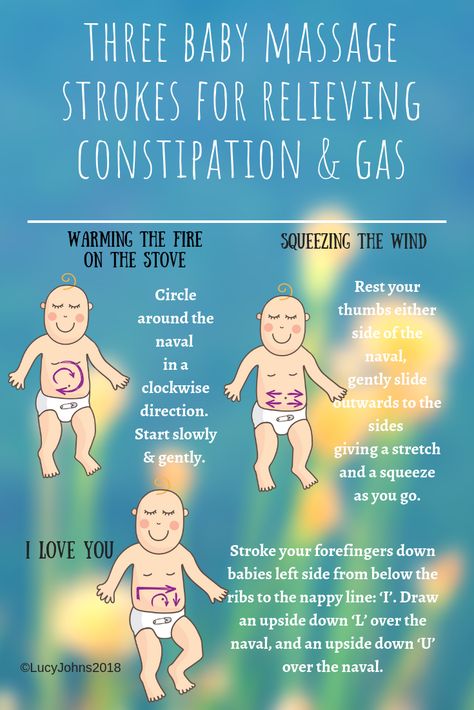 For instance, children diagnosed with autism spectrum disorder performed better on tests after a massage. The same was true for children with ADHD. Other pediatric psychiatric disorders that were also improved by massage included:
For instance, children diagnosed with autism spectrum disorder performed better on tests after a massage. The same was true for children with ADHD. Other pediatric psychiatric disorders that were also improved by massage included:
- Bulimia
- Depression
- Anxiety
Bottom line: When children and babies are massaged, they are less stressed, more alert, and notice a decrease in the symptoms of their disorder.
But is Baby Massage Safe?
Babies are known for their oh-so-soft skin, but that delicately soft skin is extremely sensitive. With all of those nerve receptors, it’s possible to overstimulate baby.
That being said, the benefits of infant massage greatly outweigh any drawbacks and is very safe if you follow a few safety tips:
- Avoid massage oil on the face: It’s too easy for it to drip into little eyes or mouths
- Avoid massaging the top of the head: Baby’s soft spot is still closing
- Avoid “deep” massages: They may be great for getting knots out of mama’s back, but little ones are not ready for the same intensity.

- Keep the massage short and sweet: While adults may like a 1 hour massage, infants need only 5-10 minute intervals of this type of touch.
- Always stop if baby shows signs she’s had enough: Such as crying, squirming, or falling asleep
- Avoid massage oils with harsh ingredients: Make sure whatever you use does not have artificial dyes, artificial perfumes, parabens, PEG, or EDTA.
- Be careful picking baby up after a massage: Massage oil can affect your grip and/or make baby slippery!
Check with baby’s pediatrician if baby has any underlying conditions that may interfere with a massage. For instance, some micropreemie babies cannot be handled too much due to changes in baby’s heart rate. Your healthcare provider can help decide what’s right for your baby.
A Note About Infant Massage
There’s no denying that some of these benefits are pretty amazing, but take your child’s lead. If he/she doesn’t like the massage, just stop for now; you can try again when baby is less fussy. The most important thing to do is keep it really simple—baby massage doesn’t have to be perfectly executed to be effective. Just be safe, have fun, and enjoy bonding with baby!
If he/she doesn’t like the massage, just stop for now; you can try again when baby is less fussy. The most important thing to do is keep it really simple—baby massage doesn’t have to be perfectly executed to be effective. Just be safe, have fun, and enjoy bonding with baby!
How About You?
Have you tried giving an infant massage to your baby? What benefits did it have for you or your baby?
Benefits, When to Start, Massage Techniques, and More
Baby massages have a variety benefits. With each gentle stroke, your baby will feel nurtured and loved, strengthening the bond between the two of you. Massages will also allow your baby to feel more relaxed, which may improve their sleep.
Some research suggests baby massage might even promote healthy growth, although further research is needed.
Not sure where to start? We’ve put together a handy guide on the benefits and techniques. It’ll teach you all you need to know about baby massages.
Baby massages are a great way to bring you and your little one closer.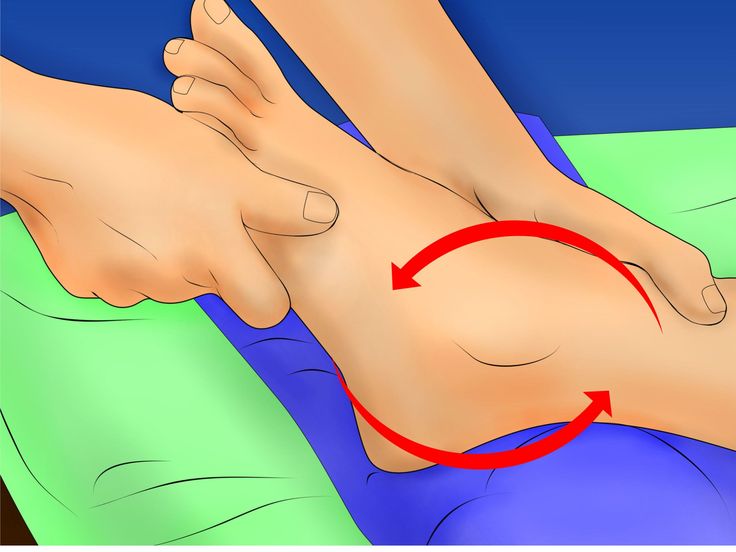 Trust and communication develop as you interact with your baby. Your calming touch will make your baby feel loved and cared for, too.
Trust and communication develop as you interact with your baby. Your calming touch will make your baby feel loved and cared for, too.
Your baby will also feel relaxed during a massage. Anecdotal reports suggest this relaxation may help improve their sleep, but more research is needed.
According to the International Association of Infant Massage (IAIM), baby massage may help to stimulate the circulatory and digestive systems. This might, in turn, help some babies with conditions such as:
- gas
- cramps
- colic
- constipation
Massages may also help ease muscular tension, growing pains, and teething discomfort, as well as stimulate growth in preterm infants.
However, a Cochrane systematic review found little evidence for these reported benefits. More research is needed to support these claims.
If your baby has any health issues, you should speak with their doctor first to decide if you should massage your baby.
The IAIM suggests that parents introduce touch as soon as the baby is born.
Many moms and dads love to do so by placing their baby on their chest, bare skin to bare skin. This is known as skin-to-skin care or kangaroo care. While you’re holding your baby close, gradually start stroking their legs and back. Then move on to other areas such as the arms.
After the first few weeks of birth, you can begin massaging your baby. However, make sure to follow your baby’s mood. Your baby should be calm, alert, and content when you’re ready to give them a massage. Never perform any massage technique that seems to make your baby uncomfortable.
It’s not the best time for a massage when your baby turns their head away from you or stiffens their arms, according to the Mayo Clinic. The Mayo Clinic also suggests waiting at least 45 minutes after a feeding. Performing a baby massage too soon after they eat can cause vomiting.
How often you massage your baby depends on you and your baby. Some parents give their baby massages daily, while other parents massage their little ones every other day.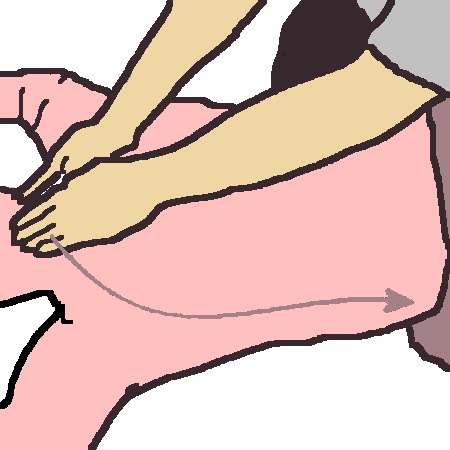
You can massage your baby during the morning to get the day going or at night before bedtime to help soothe your baby to sleep. Pay attention to your baby’s cues to help determine the best massage routine.
Here are some tips and techniques that will help you and your baby make the most of massage time.
A cozy atmosphere is essential
Massage your baby in a warm, quiet place.
Make sure you and your baby are in a comfortable spot. Place them on a towel on their back so they can maintain eye contact. This can be on their changing table or on your bed. Let them know it’s massage time as you undress them.
Start slow
Place your baby on their back and begin by slowly rubbing each body part. Your touch should be gentle at first.
Spend some time rubbing each of their body parts, starting with their head and moving gradually down to their feet. There’s no specific recommended time for the massage. Each part of the massage should last as long as you and your baby are enjoying it.
You can also try placing your baby on their belly for a short massage, though some babies may not like being on their tummies for long.
Repeat it all over again
If you and your baby are enjoying the massage, continue by repeating the rubbing motions, starting again from their head and moving down toward their feet.
Keep talking
Always communicate with your baby during the massage. Repeat their name and the word “relax” to help them calm down.
You can also tell a story or sing their favorite nursery rhyme as you move around their body.
Oil is optional
Some parents find oil too messy, while other parents use it to help eliminate skin friction from massaging. If you do use oil, make sure to buy one that’s odorless and edible since your baby may get it in their mouth.
First, test the oil by applying a small dab to a patch of your baby’s skin. Check to see if your baby has a reaction. This is especially important for babies with allergies or sensitive skin.
Baby massages are a wonderful, soothing therapy that calms your baby and promotes bonding time. However, massaging doesn’t come naturally to all parents. Don’t be discouraged if massaging your baby doesn’t work out at first.
You and your baby may have to practice a few times before getting the massage just right. With each practice, you’re developing a deeper, loving bond with your baby. Keep at it, even if you don’t get the hang of baby massages at first. Your baby will thank you.
How to massage your newborn
You are here
Johnson's® Baby
>
Baby Care Tips
>
Baby Massage
Where to buy
Views: 42 346
Last update: 06/23/2022
Average reading time: 5 minutes
Content:
034 A set of exercises
Preventive massage is becoming increasingly popular 5 among healthy babies 3 . This is not just a pleasant procedure. In addition to a lot of pleasure, the baby receives great benefits from the gentle touches of the mother.
This is not just a pleasant procedure. In addition to a lot of pleasure, the baby receives great benefits from the gentle touches of the mother.
Massage helps develop baby's muscles, prevent colds, gain weight 5 , and most importantly, strengthen the emotional bond between mother and child 2 .
How best to massage your baby
Experts recommend starting massage from the first month of life 3 . It well complements gymnastics and daily routines for child care up to the year 2.3 .
Therapeutic or rehabilitation massage is prescribed by a doctor if indicated. These may include developmental disabilities or serious illnesses. The more complex the pathology, the more carefully the technique is selected. Specialists in physiotherapy exercises, masseurs and rehabilitation specialists work with such kids 2.5 .
Preventive massage is quite possible for parents. It can be carried out independently, but only after training with a pediatrician, who provides accessible and visual instruction for moms and dads 2 .
Before the session, make sure that you have taken into account all the conditions 3 :
- Place . You can sit on the changing table, bed or on the floor. The main thing is that the chosen place is calm, warm and away from drafts. The temperature in the room should be between 22-24 or C.
- Time . For the first sessions, 6-8 minutes are enough. It is important to choose a time so that nothing and no one distracts you and your baby, and you can massage slowly. Experts recommend doing it in the evening after bathing, because gentle strokes soothe the child and help him fall asleep.
- Baby ready. The child should be awake and in good spirits. If the baby is not in the mood - naughty, crying or hungry - it is better to postpone the massage.
- Parent preparation . Remove all jewelry from your fingers, wash your hands thoroughly and dry them. To keep your baby comfortable, your hands should be warm.
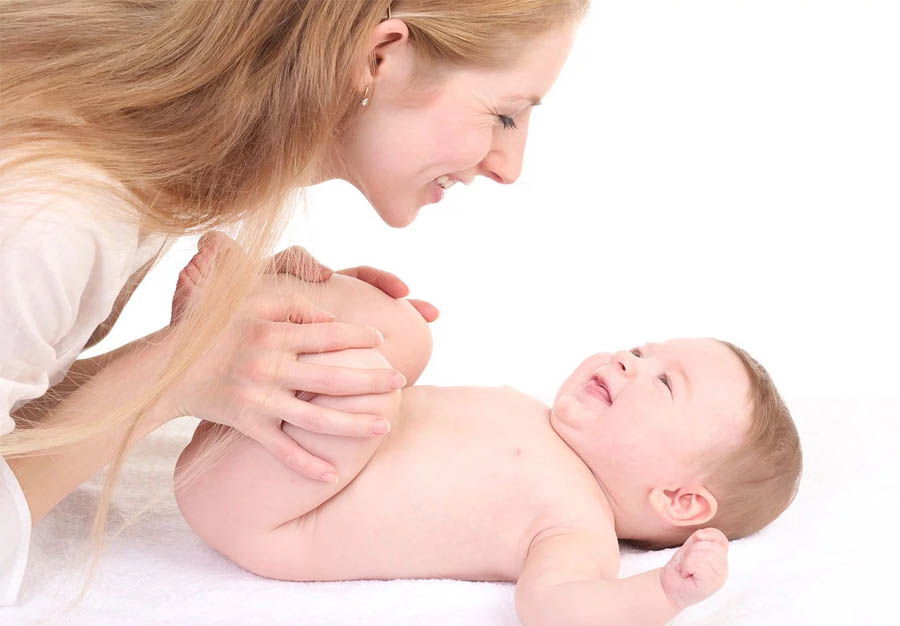 Therefore, rub them - so they will warm up.
Therefore, rub them - so they will warm up.
Baby massage somewhat limited 3 . You can massage the whole body 1 , but newborns are only allowed to stroke 3 . They should be performed gently, at a slow pace, while passive movements should be large enough to complement the child's natural motor activity 1 .
Gently stroke along the massage lines without pressure. You can talk to your child during the session. When massaging before going to bed, remember that your voice should be calm and not too emotional 3 .
European paediatricians recommend massaging children under one year of age using 4 oils. The choice of oil should be approached responsibly. There are special baby oils for newborns, such as JOHNSON'S ® Baby Oil "Cotton Delicate", which meets the needs of delicate baby skin. Hypoallergenic product 7 . It is free of dyes, phthalates and parabens 6 .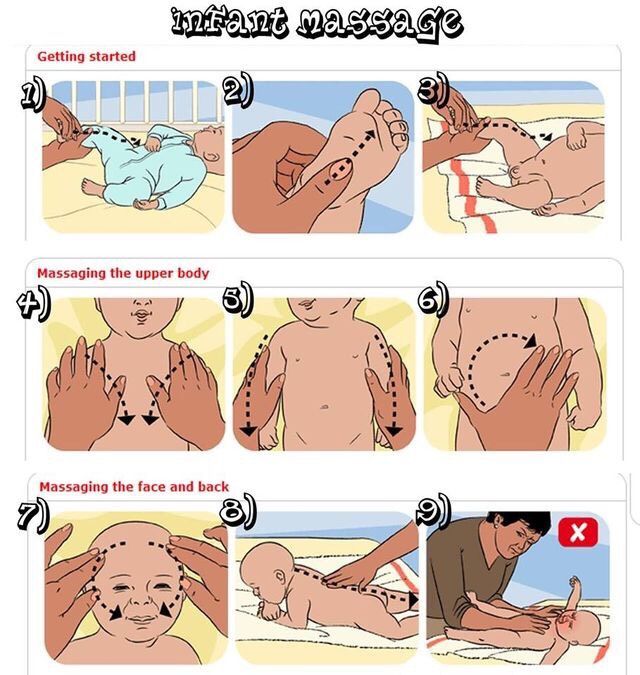 JOHNSON'S ® Cotton Tenderness Baby Oil is a plant-based formula containing coconut and cottonseed oils that absorbs quickly and protects baby's skin from dryness 3.6 and its "scent of happiness" 9 promotes baby's multi-sensory development 10-13 .
JOHNSON'S ® Cotton Tenderness Baby Oil is a plant-based formula containing coconut and cottonseed oils that absorbs quickly and protects baby's skin from dryness 3.6 and its "scent of happiness" 9 promotes baby's multi-sensory development 10-13 .
Up to content
Complex of exercises0038 3
:- Pour a small amount of baby oil into your palm. Remember that it can only be applied to dry baby skin.
- Start massaging your face and neck with your fingertips. With soft and gentle movements, draw over the baby's ears, then along the line of the eyebrows, nose and lips, as if "drawing" them.
- Move to the baby's tummy. Stroke it with your palm in a clockwise direction, avoiding the area of \u200b\u200bthe right hypochondrium, where the liver is located.
- After the abdomen, massage the chest with your thumbs, but in such a way that there is no pressure on the chest. Move from the center to the sides.
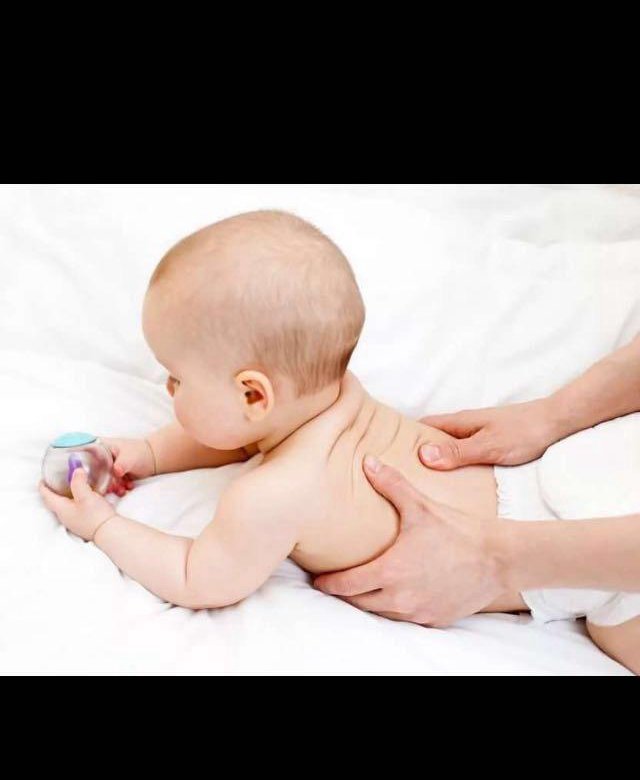
- Start massaging the arms with the hand, gradually moving up to the shoulder. Don't forget your palms. Open them and with the pads of your thumbs make circular movements several times. Then you need to stroke each finger and massage the tubercle of the thumb.
- The legs also need to be massaged from the bottom up - from the foot to the thigh. Foot massage should be given special attention - gently stroke the top of the foot, ankle and sole.
- Do a little "warm-up" for your fingers. Massage each one separately, and then apply light pressure on the sole under the fingers. In response to this, the baby will squeeze his fingers. To open them, run along the outer surface of the foot - from the little finger to the heel.
- End with a back massage. To do this, turn the child on his stomach and stroke the back from top to bottom - from the neck to the buttocks - and then back.
After the session, dress your baby in warm underwear and let him lie down quietly. If you have used oil, be sure to remove any remaining oil from your skin before putting on diaper 3 .
If you have used oil, be sure to remove any remaining oil from your skin before putting on diaper 3 .
Newborn massage is a necessary element of adequate physical activity, which has many positive effects, especially when carried out using quality baby oil 4 . The effect on skin receptors has a tonic effect on the child's nervous system 5 and promotes the physical and mental development of the child's body 2 . This is especially important in early childhood, when all the future skills of the child are laid down and basic movements are formed, for example, crawling, standing, sitting and walking 1 .
The information in this article is for reference only and does not replace professional medical advice. For diagnosis and treatment, contact a qualified specialist.
Up to contents
Literature:
- AP Romanchuk, VV Beseda. Massage gymnastics as one of the forms of physical education of young children // Pedagogy of physical culture and sports.
 - 2009. C. 94-96. https://cyberleninka.ru/article/n/massazhnaya-gimnastika-kak-odna-iz-form-fizicheskogo-vospitaniya-detey-rannego-vozrasta
- 2009. C. 94-96. https://cyberleninka.ru/article/n/massazhnaya-gimnastika-kak-odna-iz-form-fizicheskogo-vospitaniya-detey-rannego-vozrasta - A. I. Zaev, I. I. Makarova, Yu. A. Aleseeva, Z. B. Zaeva. Modern assessment and prospects for the use of physical exercises and massage in children of the first year of life // Human Ecology. - 2007. - No. 04. - C. 28-31. https://cyberleninka.ru/article/n/sovremennaya-otsenka-i-perspektivy-primeneniya-fizicheskih-uprazhneniy-i-massazha-u-detey-pervogo-goda-zhizni
- JOHNSON'S ® Care from day one. Information and educational guide for child care from the first days of life. Developed jointly with leading Russian experts.
- Blume-Peitawi U., Lavender T, Dzhenerovich D and others. Recommendations of the European Round Table on Healthy Infant Skin Care // Journal for Continuing Medical Education of Physicians. Neonatology: news, opinions, training. - 2017. - No. 1. C. 108-118.
- E.Isaeva. Children's massage. Step by step guide.
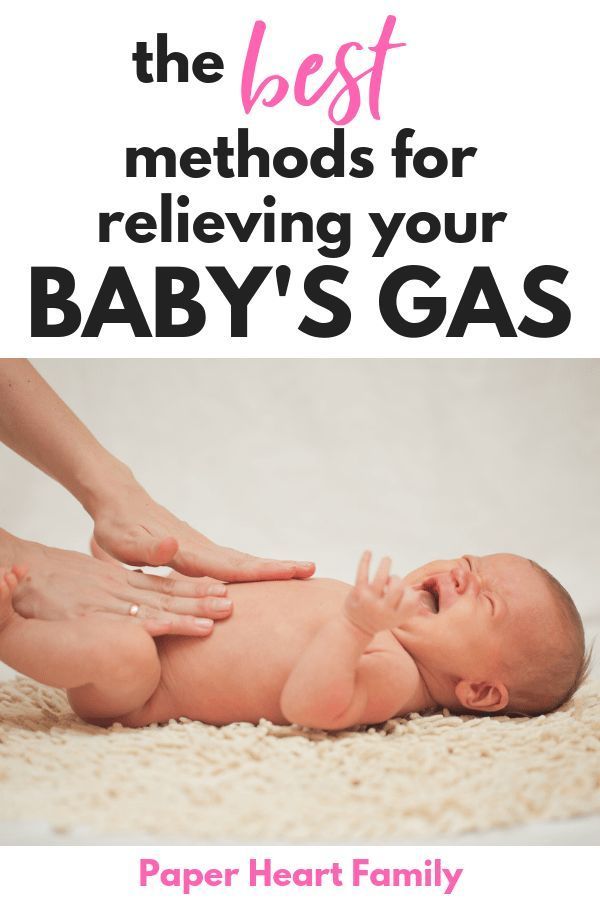 RIPOL Classic. 2008, 220s.
RIPOL Classic. 2008, 220s. - Confirmed internally by the company.
- Formulated to minimize the risk of allergies
- A study of the clinical effects of Johnson's® Cotton Tenderness on the healthy newborn skin microbiome. Kimbery Capone, Ph.D., Diana Fricia, Lorena Telofsky, Janeta Nikolowski, Ph.D., Pierluigi Cumo (Johnson’s® Cotton Softness Baby Shampoo & Wash & Bath, and Johnson’s® Cotton Softness Baby Face & Body Milk).
- Artistic image.
- Data on File, Johnson & Johnson Consumer Inc. (Johnson's CottonTouch Clinical Study Summary - Wash & Shampoo II).
- JOHNSON'S® COTTONTOUCH™ FRAGRANCE HOME USE TEST (HUT).
- Fragrance HUT: Mom Behavioral Analysis Global HUT by Symrise.
- Cotton Tenderness global survey: shampoo and foam, lotion, oil, powder. Number of respondents: 316 mothers. survey period: 2016-2017.
Back to top
Massage for children under one year old
Children's health is the main thing in the life of parents. And the life of the baby depends on how seriously and responsibly adults approach the issue of the health and development of the child.
And the life of the baby depends on how seriously and responsibly adults approach the issue of the health and development of the child.
Many experts agree that in the first year of life a child is like plasticine - everything you put into it, what foundation you give, with that it will go through life. And regardless of whether your baby was born healthy or with small (or large) deviations from the norm - you need to deal with him! In this case, I mean the physical development of the child, namely, massage, with the help of which healthy children are ahead of their peers in development, and children with serious illnesses get a chance to become full members of society.
You have no idea what miracles massage can do!
Time is running out and you can't get it back. And in order not to regret missed opportunities in the future, take care of your child's health now, do not delay!
Therapeutic properties of massage
Massage is divided into therapeutic, corrective and preventive.
Preventive massage contributes to the full development of the child's body. Parents, on their own initiative, turn to a children's massage therapist or do the massage themselves. Massage for a healthy child can be started from 1.5-2 months. Before you massage your child yourself, consult a pediatrician.
Treatment and correction are prescribed by a pediatrician, depending on what pathologies have been identified by a pediatric neuropathologist, orthopedist or surgeon. By the time your baby is 2 months old, you should definitely visit these specialists. Feel free to ask questions that interest you, tell everything that worries you. The correctness of the diagnosis depends on this. If something does not suit you in the answers or you doubt the competence of the doctor, go to another specialist. You cannot risk your child's health. We are a little off topic, but this is a really important point that should have been touched upon. Let's return to massage, namely, I would like to draw your attention to what diseases massage helps to cope with in the first year of a child's life.
These are diseases of the musculoskeletal system (dysplasia, clubfoot, flat feet, scoliosis), therapeutic diseases (hernia, rickets, malnutrition, torticollis, hypertonicity, hypotonicity), respiratory diseases (pleurisy, bronchitis, bronchial asthma, rhinitis), diseases of the stomach -intestinal tract and central nervous system.
If your baby has a medical condition or was born prematurely, a pediatric consultation is a must! Please do not self-medicate, contact the professionals!
Contraindications to therapeutic massage
If the pediatrician who sees your child has identified any of the following diseases, massage is contraindicated for the baby. These are diseases such as: all acute febrile diseases, purulent and other acute inflammatory lesions of the skin, subcutaneous tissue, lymph nodes, muscles, bones (eczema, pemphigus, impetigo, lymphadenitis, phlegmon, osteomyelitis, etc.), diseases accompanied by fragility and painful bones, acute forms of rickets, acute forms of arthritis, tuberculosis of bones and joints, congenital heart disease, acute forms of nephritis, hepatitis, large umbilical, femoral, inguinal and scrotal hernias with significant prolapse of the abdominal organs or with a pronounced tendency to infringement. In all other cases, in the presence of a hernia, massage is done with mandatory fixation with an adhesive bandage.
In all other cases, in the presence of a hernia, massage is done with mandatory fixation with an adhesive bandage.
And once again, if your child has health problems, massage treatment should be carried out strictly according to the indications of the attending physician and only with the participation of a professional children's massage therapist. I emphasize, childish! It is important.
Where to find a baby massage therapist
Let's talk about where to find a professional to whom you entrust the health of your baby. First of all, you need to decide what result you want to achieve. If your child is healthy, then you can work with him at home on your own. Revitalizing massage is not difficult. A little later, you can get acquainted with the basic techniques and rules for massage. But if your child has health problems, then you definitely need a specialist. Where to find it? Possible options are shown below.
- Municipal Children's Clinic. Pros: the massage therapist is guaranteed to have a medical education, the service is free.
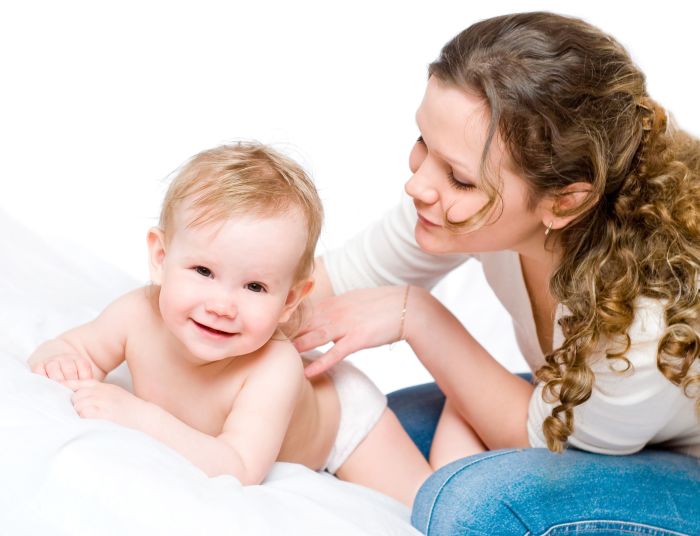 Cons: Massage appointments are usually several months in advance, and you will also have to travel on your own.
Cons: Massage appointments are usually several months in advance, and you will also have to travel on your own. - PartPrivate individuals who practice part-time massage. Pros: Home visits available. Cons: you need to verify the qualifications of the massage therapist by checking his documents; paid service. paid clinics. Pros: a friendly attitude is guaranteed, home visits are possible for an additional fee, of course. Minus: the qualifications and experience of a massage therapist are not guaranteed (how lucky), the service is quite expensive.
- Part-time private massage practitioners. Pros: Home visits available. Cons: you need to verify the qualifications of the massage therapist by checking his documents; the service is paid.
- Children's rehabilitation centers (there are paid and free). Pros: qualified professionals. Cons: You have to travel on your own.
Parents often choose a massage therapist who is recommended by friends and acquaintances, regardless of where he works.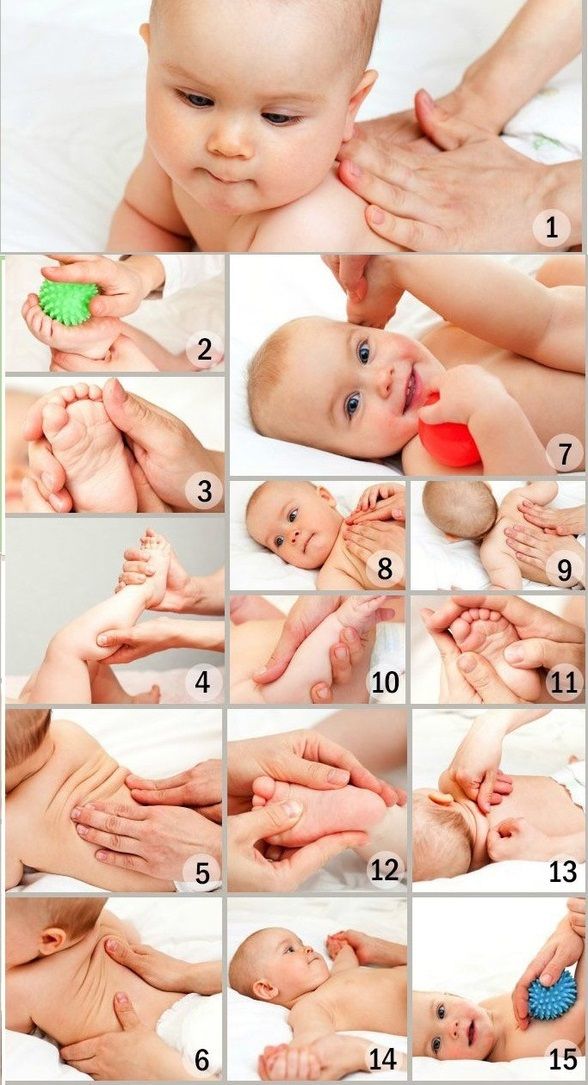 Perhaps this is correct. The choice is yours. Analyze all the options available to you.
Perhaps this is correct. The choice is yours. Analyze all the options available to you.
Rules for baby massage
I would like to draw the attention of those readers who decide to massage a child on their own to the basic rules for massage:
- do not forget about the child's positive attitude. It is important that the baby was in a good mood, not hungry and slept well. Massage should be carried out about an hour before feeding or 30-45 minutes after it;
- be kind and friendly. This will help to establish contact with the child;
- you must be comfortably dressed, your nails trimmed, no jewelry on your hands (so as not to accidentally damage the delicate skin of the baby). Hands must be clean and warm;
- it is better not to use creams, oils, powders, so as not to cause allergies;
- the room should be ventilated, well lit. The air temperature is not lower than twenty-two degrees. If you feel that the room is a little cooler, the child should be covered with a warm diaper, except for the massaged area, of course;
- massage is best done on a hard surface (on a changing table or on a regular table, you can put a thin blanket on it), so that you can approach it from different sides;
- to begin with, use simple techniques, gradually complicating them, adding new elements;
- massage gently, do not make sudden movements;
- after the massage, it is recommended not to go outside for at least 30 minutes;
- massage is not recommended before bedtime;
- and never leave a child alone without supervision!
Massage for a child is not only a health-improving procedure, but also positive emotions, don't forget about it.
Technique of general strengthening children's massage
I think, while reading, you had questions like: “How to massage correctly?”, “What movements?”. Let's figure it out.
The duration of the set of exercises for the first lessons is approximately 3-4 minutes, then gradually increase to 15 minutes. But remember, everything is individual. If the baby began to act up or express obvious displeasure, try to distract him and move on to the next exercise. If the child does not calm down, stop the massage, continue later.
Let's talk about the technique of massaging a child up to a year in more detail. Remember, all your movements should be directed to the center (from the hand to the elbow, from the elbow to the shoulder and from the heels to the knee, from the knee to the groin). And don't forget - no sudden movements!
Massage of a child up to a year includes the following techniques: stroking, rubbing, kneading, vibration. Let's take a closer look at each of them.
- Stroking. The stroking technique is shown to children literally from birth. The touch of warm mother's hands will soothe the baby. For the first three months of your baby's life, use this technique exclusively. As you get older, start and end each massage session with strokes, as well as between rubbing, kneading, and vibrating. Gentle strokes relax, prepare the skin for further manipulations. Your movements should be smooth and light.
- Rubbing. You can use this massage technique when your baby is 3 months old. Rubbing the skin of the child should be intensive, but gentle. Just grind, not stretch. You can rub with the ball of your thumb or the base of your hand, in a circle or in a straight line. There are different exercises in which you will need this or that method.
- Kneading. This technique is associated with how the dough is kneaded. But do not forget the skin of the child is very delicate, you can not press hard. Perform movements vigorously, but gently.
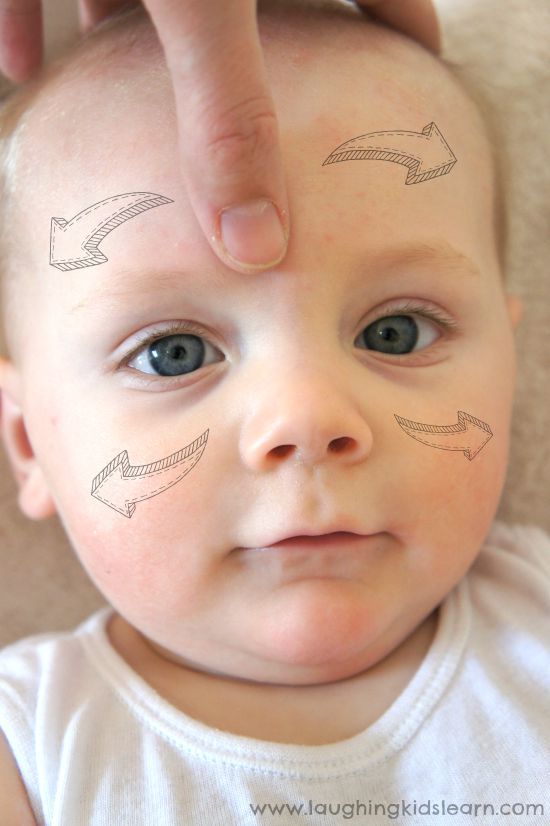 Using this technique, you work on the muscles of the child. Therefore, perhaps the first time your baby will be dissatisfied with the use of this technique. Treat this with understanding, try to distract him with a bright toy, talk to him. Increase the duration of the exercise gradually. After a few days, he will get used to it and will enjoy it. Knead your child's muscles with the pads of your fingers when pinching the skin, and with the base of your entire hand when using the felting method (more on that in a moment).
Using this technique, you work on the muscles of the child. Therefore, perhaps the first time your baby will be dissatisfied with the use of this technique. Treat this with understanding, try to distract him with a bright toy, talk to him. Increase the duration of the exercise gradually. After a few days, he will get used to it and will enjoy it. Knead your child's muscles with the pads of your fingers when pinching the skin, and with the base of your entire hand when using the felting method (more on that in a moment). - Vibration. This technique is soft tapping, tapping with the fingertips or the edge of the palm. In no case do not press hard! Usually vibration is used for chest and back massage.
Basic methods of massaging a child from birth to a year
There is a conditional calendar of a child's development (at that age he should be able to do this, at another age he should do that). And in order to prepare the baby's muscles for a certain load, they perform various exercises using the appropriate massage technique.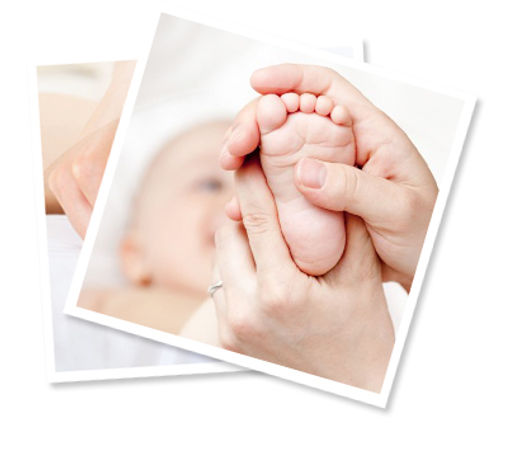 It is for this reason that I advise readers to use massage techniques in accordance with the age of the child.
It is for this reason that I advise readers to use massage techniques in accordance with the age of the child.
So, let's focus on the basic massage techniques for children under one year old.
Child's age 1.5-3 months
As mentioned earlier, doctors recommend starting massage from 1.5 months. But why such a gradation, up to 3 months? If you look at a newborn, it will immediately catch your eye that his arms are clenched into fists and bent at the elbows, his legs are also bent. By 3 months it should be gone. But in no case should you sharply remove muscle tone. Therefore, for children of this age, use only the stroking technique.
Start with a hand massage. Lay the child on his back so that he lies with his feet towards you. When massaging the baby's right hand, hold it with your left hand, and vice versa, when stroking the baby's left hand, hold it with your right hand. Hope you don't get confused. It doesn't really matter, it's just convenient. And do not forget: from the hand to the elbow, from the elbow to the shoulder.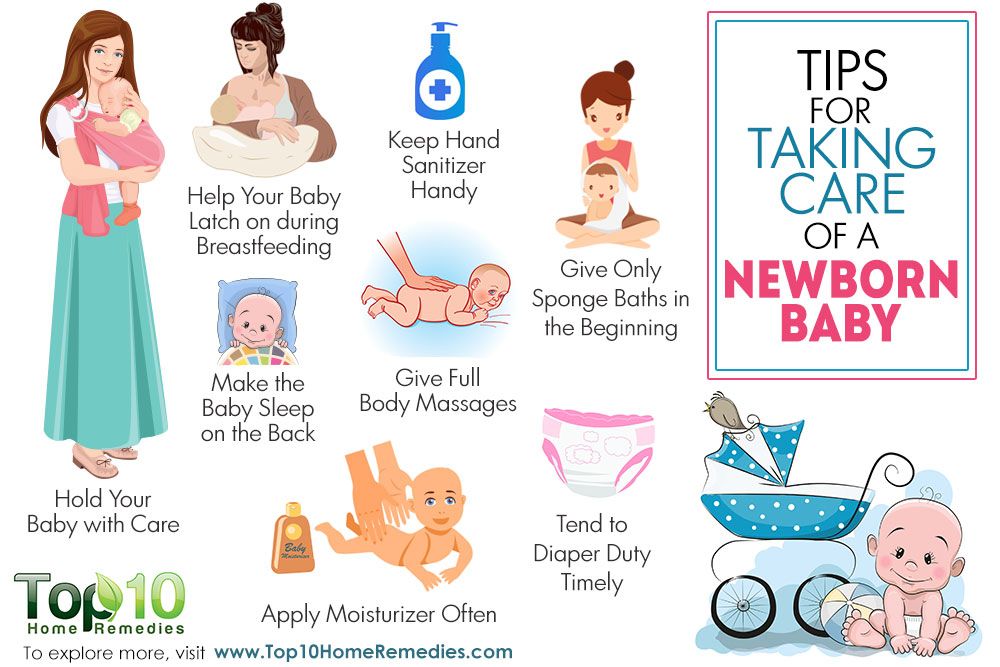 Stroking with the palm of your hand from the inner surface of the child's hand.
Stroking with the palm of your hand from the inner surface of the child's hand.
Now let's talk about foot massage. Let the child remain in the same position. With light hand movements, massage the entire surface of the child's leg, excluding the knee area and the front of the lower leg. And do not forget, your child should enjoy the massage process. As for the foot massage, move your thumb in circles from top to bottom and from bottom to top, as if drawing a figure eight, gently stroking each finger. This is a very useful exercise, because, as you know, there are many points on the human foot, the massage of which affects the entire body.
Breast massage at this age is light stroking with the palms or the back of the hands. Your movements should be directed from the middle of the chest to the sides. Then go down and start massaging the abdomen. Circular stroking clockwise helps to relieve the baby of abdominal pain. This is a very pleasant soothing exercise for the child.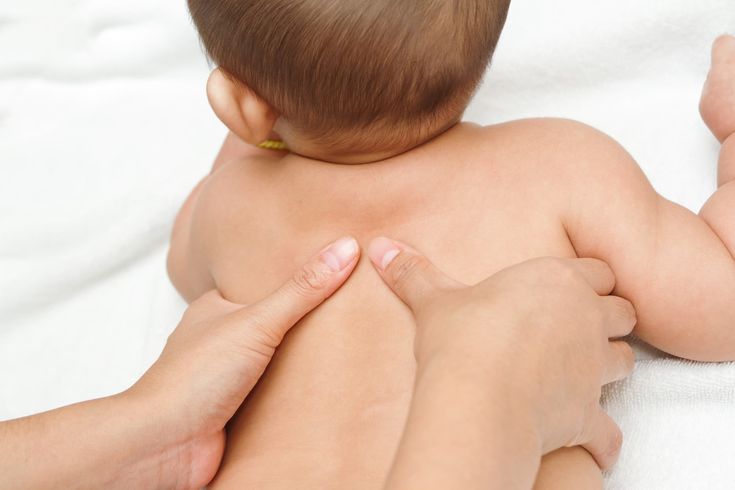 Then do the following exercise: move up and down alternately with the palm and back of the hand. Next, use this technique: wrap your arms around the baby’s lower back and stroke in the direction of the baby’s stomach. Performing all these exercises, in no case do not put pressure on the right side of the child. Move on to a back massage.
Then do the following exercise: move up and down alternately with the palm and back of the hand. Next, use this technique: wrap your arms around the baby’s lower back and stroke in the direction of the baby’s stomach. Performing all these exercises, in no case do not put pressure on the right side of the child. Move on to a back massage.
I advise you to perform a back massage in the following way: from the bottom up, stroke the child's back with the back of your hand, and from the top down with your palm. There is no strict recommendation on the timing of each massage, but focus on about five repetitions of each exercise.
The child is 3-4 months old.
At this age, the child should be able to hold his head well, lying on his stomach and leaning on his forearms, for about four months the baby should raise his shoulders and head, lying on his back. And to prepare his muscles, I recommend using such a technique as rubbing. But do not forget: you need to start and end each exercise with strokes (the features are described in detail above), performing each exercise about 2-3 times.
The algorithm of your actions does not change, start with a hand massage. Rubbing is carried out as follows: grab the child’s wrist with your thumb and middle finger (or index finger, whichever is more convenient for you) and move from the wrist to the elbow and from the elbow to the shoulder, making twisting movements. When you have finished massaging both hands, do the same with the child's legs, but do not massage the knee area.
Continue with foot massage. Rubbing the feet includes: circular rubbing with the ball of your fingers (draw a figure eight) and rubbing the inside and outside of the foot from the heel to the toes. I also recommend adding light tapping. Straighten your index and middle fingers and rhythmically, but gently tapping, move from the heel to the fingers and back.
When rubbing the chest, do it carefully - rhythmically, but very lightly press on the baby's chest. In no case do not put pressure on the ribs! Direct movements from the middle of the chest to the sides.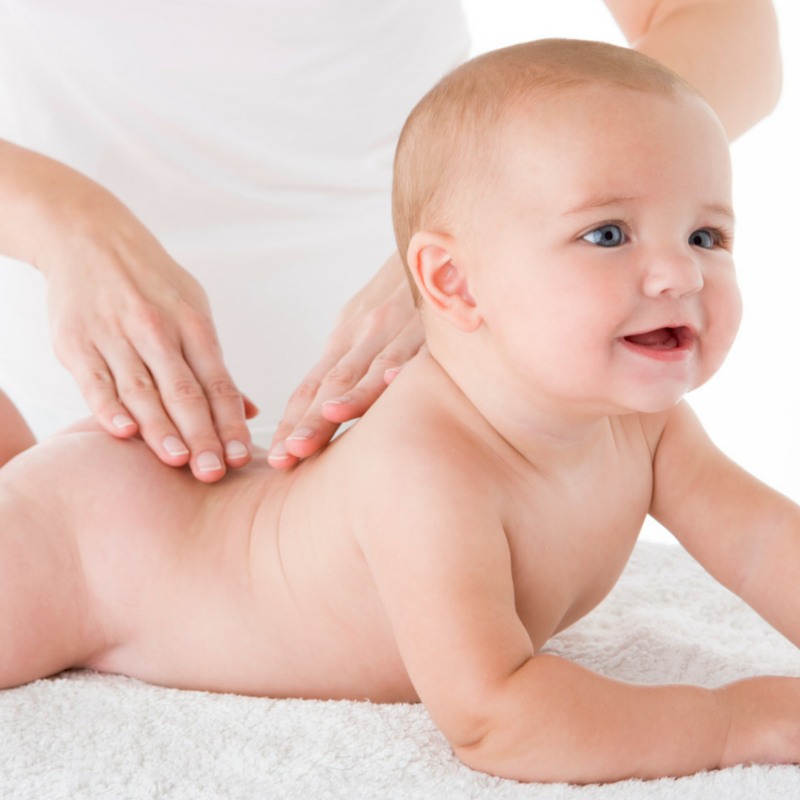 Then massage the abdomen with the pads of bent fingers, clockwise. Do not put pressure on the liver! "Draw" circles around the baby's navel. Your child will love this exercise! Then proceed to massage the buttocks and back.
Then massage the abdomen with the pads of bent fingers, clockwise. Do not put pressure on the liver! "Draw" circles around the baby's navel. Your child will love this exercise! Then proceed to massage the buttocks and back.
Rubbing the buttocks and back should also be carried out with the pads of bent fingers. Watch the movements of the hands: one should move the baby's skin up, the other down. Gradually move from the buttocks to the neck. The next technique, which is used in massage for children of this age, is simultaneous multidirectional circular movements (right hand clockwise, left hand against).
The child is 4-6 months old.
At this age, the child must be able to roll over, so it is necessary to prepare the muscles of the abdomen and back. And, of course, legs, because the turn occurs precisely due to the fact that the child throws one leg over the other and transfers body weight. I draw the attention of readers to the fact that now kneading is added to stroking and rubbing.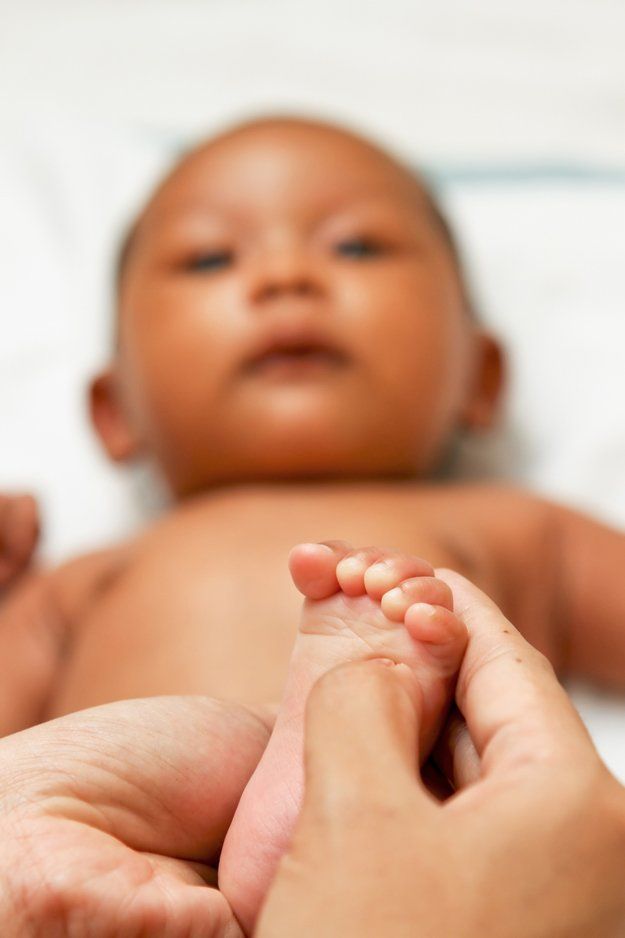 That is, you perform all the same actions, in the same order, enter a new element (kneading) after rubbing.
That is, you perform all the same actions, in the same order, enter a new element (kneading) after rubbing.
Techniques for massaging the hands, feet and chest of a 4-6 month old baby are similar to massage techniques for a 3-4 month old baby, that is, first stroke, then rub, then stroke again.
The main method of foot massage for a child of this age is kneading. Imagine that you are kneading dough. But do not forget, the movements are soft and accurate. Another technique is called felting. Place the child's foot between your palms and make vigorous movements in opposite directions (imagine that you are trying to make something out of snow, give shape).
Massage the abdomen in the same way as when the child was 3-4 months old, but add a new element - pinching around the navel. This exercise will strengthen the abdominal muscles and give pleasure to your baby.
A new element that I recommend introducing for back and buttocks massage is sawing. Sliding movements, up and down, are performed with the edge of the palm along the entire back of the child.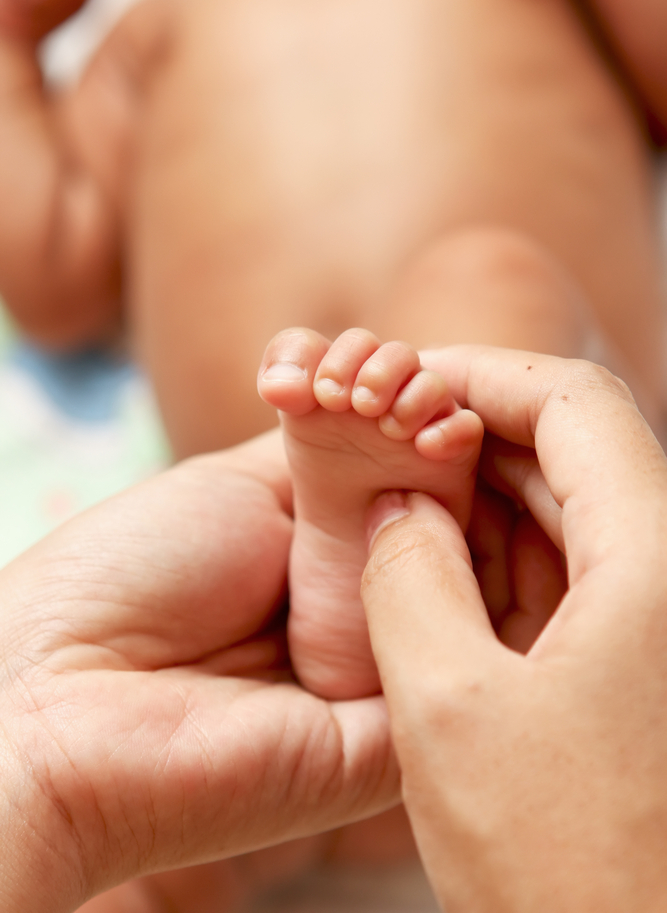 Another trick you can add is shifting. Alternately fingering, move the skin of the child from the bottom up. Next, move on to the buttocks. Just do not touch the lumbar region in any case. Applying the technique, pinching and tapping, you will improve blood circulation, and when the baby's skin turns pink, I advise you to finish the massage with strokes. And don't be afraid to do something wrong. Your child will “tell” you, you will definitely feel if it hurts or is unpleasant for him.
Another trick you can add is shifting. Alternately fingering, move the skin of the child from the bottom up. Next, move on to the buttocks. Just do not touch the lumbar region in any case. Applying the technique, pinching and tapping, you will improve blood circulation, and when the baby's skin turns pink, I advise you to finish the massage with strokes. And don't be afraid to do something wrong. Your child will “tell” you, you will definitely feel if it hurts or is unpleasant for him.
Age 6-12 months
All the same techniques as described above are used. I recommend watching a training video on baby massage, it can be easily found on specialized massage sites on the Internet. And the last tip. Start exercising with your child as early as possible and daily. It will be much more difficult for you to start massaging a nine-month-old baby, simply because it is difficult to keep him still for more than ten seconds. That, perhaps, is all that I wanted to tell you about baby massage.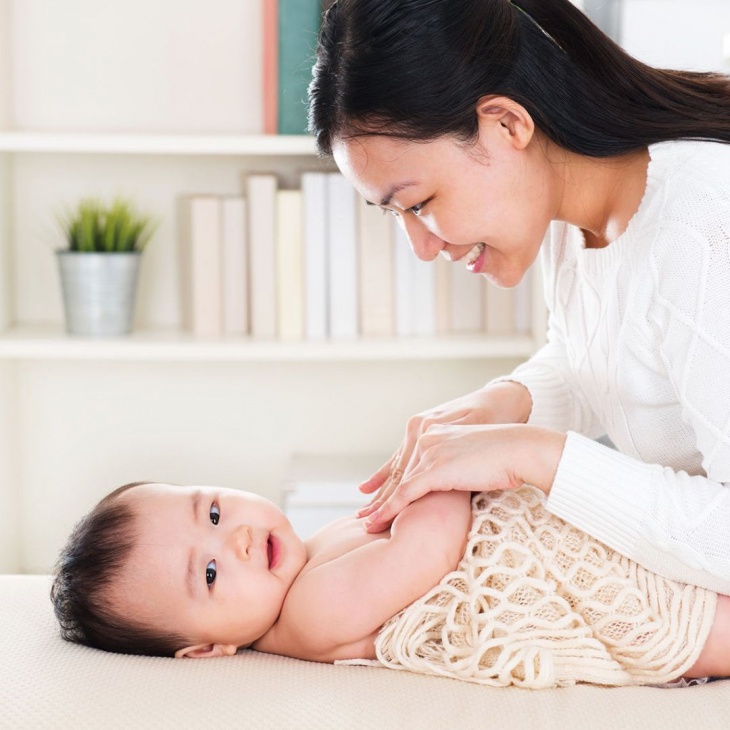 I think this information will be useful for you!
I think this information will be useful for you!
So let's sum it up. Massage of a child up to a year is the treatment and prevention of many diseases. I hope I managed to convince you of the benefits of massage. And you have a dilemma: to contact a specialist or do the massage yourself?
Option one. Seek help from a specialist. The choice in the market of paid medical services is now great, plus there are free clinics and centers. And the qualifications of all specialists are different. Seriously approach this issue, the health of your child depends on it.
Option two. Do the massage yourself. When choosing this option, do not forget about compliance with the prerequisites: consultation with a doctor (pediatrician), the child’s absence of diseases in which massage is contraindicated, the implementation of certain massage rules, knowledge of the technique and basic massage techniques.
In fact, no matter which option you choose, you must clearly realize that you must give your child the maximum of all the best, useful, kind (health, useful and correct habits, norms of behavior, etc.

